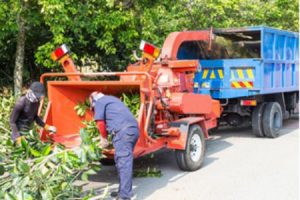 Avoid Chipper Accidents; Follow These Precautions:
Avoid Chipper Accidents; Follow These Precautions:
- Suit up for the job. Anyone working near a chipper should wear eye and hearing protection, tight-fitting clothing, a hard hat or helmet, and gloves with no cuffs. Work boots with skid-resistant soles can prevent slips and falls near the feed chute. Leave the jewelry at home and tie up long hair.
- Know the machine. Before operating a chipper, get familiar with the operation of the machine, its safety controls, and proper start-up and shut-down procedures. Know how to stop or reverse it in case of emergency.
- Inspect it before each use or at the start of each shift. Check the infeed area for foreign objects. Look for missing or loose bolts and pins (every chipper manufacturer specifies torque levels for the knife bolts and nuts). Inspect the knives for wear or damage. Running the chipper with worn or damaged knives can cause the feed to clog and eventually kick debris back through the feed chute.
- Check the guards. Make sure they’re not missing. Many chipper accident reports cite the absence of guards or malfunctioning safety devices.
- Point the discharge chute away from people. This one’s obvious but still worth mentioning.
- Have someone stand near emergency shutoff devices while the operating is feeding the machine. An operator caught in a commercial woodchipper has very little time to work free or reach and activate a safety device.
- Check the material before you feed it to make sure it doesn’t contain foreign objects.
- Stay free and clear as you feed. OSHA recommends standing to the side of the infeed chute, pushing materials in with a wooden push tool or long branch, feeding branches in butt-end first, and placing shorter branches on top of longer ones (put small debris in the trash, not in the chipper).
- Immobilize the disk or roller when clearing a chute or changing chipper blades.
IGNORING SAFETY RULES…CAN PROVE TO BE FATAL!!
Download flyer: STOTW_1032_Wood Chipper Safety
Download Spanish: STOTW_1032_Wood Chipper Safety_esp
 Avoid Chipper Accidents; Follow These Precautions:
Avoid Chipper Accidents; Follow These Precautions:
